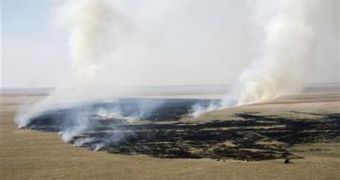As we already know, the last two Soyuz capsules used to return astronauts from the International Space Station executed 'ballistic' re-entries into Earth's atmosphere during descent, possibly endangering the lives of the crew they were carrying. As it turns out, both ships may have suffered from the same glitch that is possibly also plaguing the Soyuz-TMA-12 spacecraft now stationed at the ISS, expected to return the crew of Expedition 17 to Earth in October. The Russian space agency has still to comment on the technical problems of its spacecrafts but apparently they are safe for travel.
The Soyuz-TMA-11 capsule, returning to Earth in April and carrying ISS commander Peggy Whitson, flight engineer Yuri Malenchenko and South Korea's first astronaut Yi So-yeon, is only the latest example of the streak of two unusual descents. The spacecraft entered the atmosphere at a steeper angle than expected, subjecting the crew to nearly twice the usual gravitational forces and ultimately landing at about 420 kilometers away from the designated landing spot.
According to space industry sources cited by Reuters, the cause of the unusual behavior can be traced to the explosive bolts used to separate the capsule from the Soyuz module. "There are explosive bolts which keep two modules attached to Soyuz capsules. They are supposed to go off right before the entry into the Earth's atmosphere. For some reason this didn't work (on the previous two re-entries), although the unseparated modules fell off eventually. What is bad is that another Soyuz-TMA is believed to have this faulty device and is docked at the ISS for the return trip", said the source which preferred to remain under anonymity.
Although the investigation regarding the two landings has been completed, Roskosmos preferred not to disclose any details regarding the result and the technical faults experienced with the Soyuz capsule. Spokesman Alexander Vorobyov, however, said that Roskosmos believes that the spacecrafts are still safe for further returns.
"He said that in any case, even in the event of a ballistic landing, these explosive bolts burn down due to high temperatures on re-entry, and then the descent - even if it is not so gentle - won't be life-threatening for the crew", said Vorobyov while referring to the discussion with the Russian ISS flight director Vladimir Solovyov.
Meanwhile, NASA has finally started asking Roskosmos some questions regarding the safety of the Soyuz landers, after previously saying that the two consecutive re-entries were not worrisome in any way.
The source also added that the explosive bolts used to separate the two modules of the Soyuz spacecraft detached too late, thus causing the capsule to enter the atmosphere at an incorrect angle and facing the wrong way - hatch first, the heat-shield facing exactly the opposite direction - causing significant damage to both the antenna and the hatch.
In the outcome of the descent, the Korean astronaut appears to have suffered back injuries and later said that she even feared for her life during the landing.

 14 DAY TRIAL //
14 DAY TRIAL //